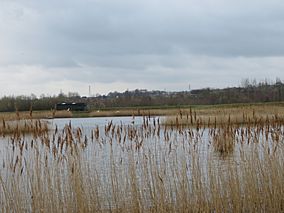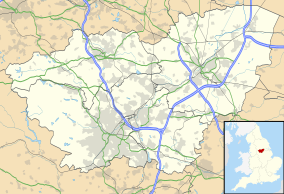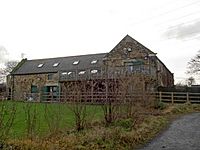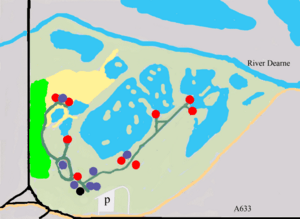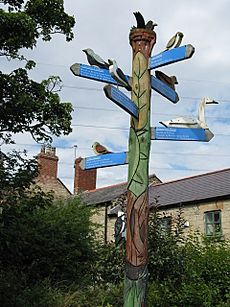RSPB Dearne Valley Old Moor facts for kids
RSPB Dearne Valley Old Moor is a special place in South Yorkshire, England. It's a wetland nature reserve, which means it has lots of water and marshy areas. The reserve is managed by the Royal Society for the Protection of Birds (RSPB). It covers about 89-hectare (220-acre) (that's like 220 football fields!).
This area used to be a place for coal mining. After the mines closed, the land was empty and damaged. So, people decided to turn it into a home for wildlife. The RSPB took over in 2003 and made it even better.
Old Moor is a great spot for many birds. You can see rare birds like bitterns and avocets. It's also a safe place for birds like tree sparrows and willow tits, which are becoming rare in other parts of the UK. The reserve is popular, with about 100,000 visitors each year. It's designed to be a fun place for families to learn about nature.
Contents
History of Old Moor
The Dearne Valley area has been home to people for a very long time. Mining started here many centuries ago. By the 18th century, the area was full of heavy industries like coal mining and iron production. The Dearne and Dove Canal and later railways helped these industries grow.
The name Old Moor might come from an old word for a marshy, wet area. This land was used as a farm by 1757.
From Coal to Nature Reserve
The Dearne Valley was once a huge coal mining region. In the 1950s, over 32,000 miners worked in 30 different coal pits! The mining industry caused a lot of pollution. The River Dearne became so polluted that nothing could live in it.
In the 1980s and early 1990s, all the coal mines in the Dearne Valley closed. This meant 11,000 people lost their jobs. A huge area of land, about 600 hectares (1,500 acres), was left empty and polluted. To clean it up, workers removed 700,000 tonnes (690,000 long tons) of soil from nearby Old Moor. This removed the pollution and created a perfect space for a new wetland.
The Wildfowl & Wetlands Trust (WWT) first planned to run the reserve. They wanted a big lake for winter birds. But the RSPB suggested adding special reed beds. These would help the bittern, a rare bird that was struggling in the UK. The WWT decided not to take on Old Moor because they were busy with another big project.
So, Barnsley Metropolitan Borough Council created the reserve, and it opened in 1998. The RSPB then took over in 2003. They had changed their mind about creating new habitats. They now wanted to work with the public and create more wetlands. With help from different groups, the RSPB grew its land in the area to 309 hectares (760 acres) over ten years.
Many groups now work together to protect and improve the Dearne Valley. This includes the RSPB, local councils, and other wildlife charities. Their goal is to create a huge area where wildlife can thrive. In 2020, the BBC show Autumnwatch even broadcast from Old Moor!
Visiting Old Moor
Old Moor is easy to reach from major roads. It's about 6.5 kilometres (4.0 mi) from the M1 motorway. You can also get there by bike using the Trans Pennine Trail, a long-distance path that runs along the reserve.
The reserve has a visitor centre, which used to be farm buildings. Here you'll find a shop, a café, toilets, and places to have a picnic. There are also play areas and nature trails for exploring. The visitor centre is open every day, except for Christmas Day and Boxing Day. RSPB members can enter for free, but other visitors pay a small fee.
Old Moor was designed to be an "Urban Gateway" site. This means it's meant to attract many visitors, especially families. It has a playground, a café balcony, and a children's discovery zone. There are also nine bird hides and viewing screens. These are great for watching birds without disturbing them. One hide even has a special reflection pool for photographers.
Managing the Reserve
The main goal at Old Moor is to look after its key habitats. These are wet grasslands, open water, and reed beds. The first reeds were planted in 1996. It was hard for them to grow because the soil was very tough clay. Bringing in fertile mud from another reserve helped.
The reed beds are cut regularly to help new reeds grow. They are divided into four sections that can be drained separately. This helps manage the water levels.
Caring for Wet Grasslands
Wet grasslands are kept short for breeding birds like lapwings. This is done by letting cattle or Konik horses graze there, or by mowing. Ditches are cleaned in turns. Islands are flooded in winter to stop too much vegetation from growing. Then, plants are cut down, and the soil is broken up to help new growth and stop unwanted weeds.
Old Moor has a clever water system. This allows staff to control water levels in different parts of the wetland. In winter, water levels are kept high. Then, they are lowered to create islands for breeding birds and migrating birds to rest.
Old Moor is part of a bigger plan to create wildlife habitats in the Dearne Valley. This plan involves working with other wetland reserves nearby. The RSPB manages five smaller sites close to Old Moor. Other wildlife groups also manage reserves in the area. All these efforts help create a large, connected home for wildlife.
Wildlife at Old Moor
Old Moor is a fantastic place to see many different animals and plants.
Birds of Old Moor
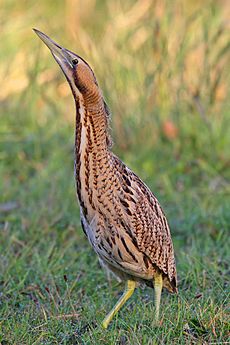
Since the 1990s, the RSPB has worked hard to help the bittern population. These birds were once very rare in the UK. At Old Moor, new reed beds were created for them. Also, thousands of small fish like rudd and eels were added. Bitterns love to eat these fish! This project helped the fish population grow a lot, which means more food for the bitterns.
Many wading birds breed at Old Moor. These include lapwings, redshanks, and avocets. Avocets have been breeding here since 2011. Sometimes, foxes try to eat the chicks. So, deep ditches and electric fences are used to keep mammals away.
Black-headed gull numbers have grown a lot, from 183 pairs in 2006 to over 2,300 pairs in 2017. Mediterranean gulls have also started to appear. Old Moor is an important winter home for golden plovers.
You can also find small birds like tree sparrows and willow tits. Willow tits are disappearing in many parts of the UK. But their numbers are actually increasing at Old Moor! The new trees and plants in the area have created a perfect home for them. Birds like Cetti's warbler and bearded tit have recently moved in. Up to three pairs of barn owls also breed here.
Rare birds sometimes visit Old Moor. A male little bittern was seen in the summers of 2015 and 2016. Other rare visitors have included a Baird's sandpiper, a thrush nightingale, and a black stork.
Other Animals and Plants
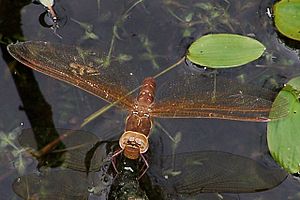
Besides birds, Old Moor is home to other interesting animals. Rare mammals like Lesser noctule bats and water voles live here. Otters have also returned to the now-clean rivers. You might also spot brown hares and pipistrelle bats.
Many unusual insects can be found at Old Moor. The alder leaf beetle, once thought to be gone from the UK, now lives here. Other rare insects include the great silver water beetle and the dingy skipper butterfly. You can also see many types of dragonfly and damselfly.
Rare plants also grow at Old Moor. These include yellow vetchling and hairy bird's-foot trefoil. In summer, you can see marsh orchids and bee orchids flowering in the grassy areas.
Future of Old Moor
The Dearne Valley is a natural washland, which means it can usually hold extra water from the river. However, in the floods of 2007, the water was so high that it covered almost all of Old Moor. Only the visitor centre stayed dry. In the future, climate change might affect the reserve, possibly changing which species live there.
But there are also many good things happening. The local environment is getting better, and more habitats are being created outside the reserve. It's also becoming easier for people to visit. Surveys show that many local people love visiting the wildlife reserves and waterways in the Dearne Valley. They especially enjoy the nature and wildlife.
The success of Old Moor has inspired other similar RSPB reserves. These new reserves are also close to cities, like Rainham Marshes near London and Newport Wetlands in South Wales. They all aim to bring nature closer to people in urban areas.


